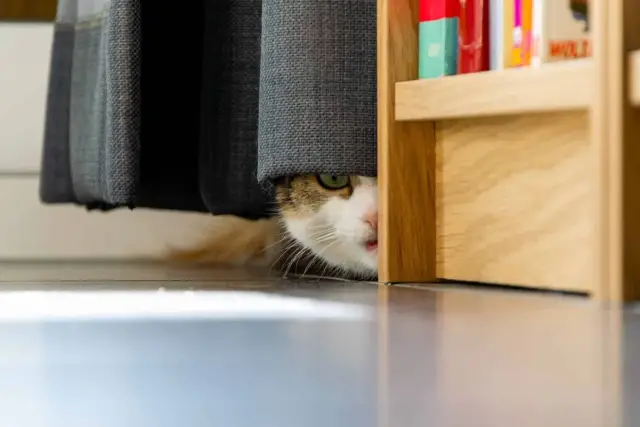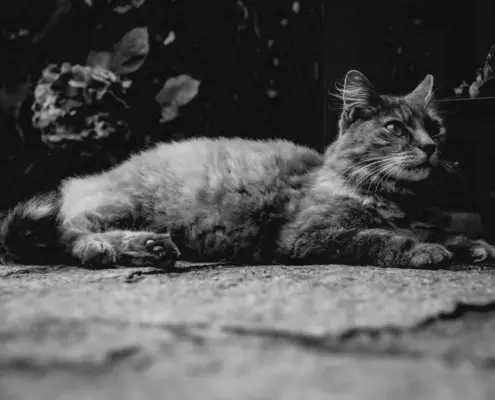
Cats, known for their mysterious and independent nature, can also experience fear just like any other living being. Understanding the psychology of fear in cats is crucial for providing them with a safe and secure environment. Fear in cats can be triggered by various factors, including traumatic experiences, unfamiliar environments, or even genetic predispositions. It is important to recognize that each cat is unique and may have different fears. By delving into the psychology of fear in cats, we can gain a deeper understanding of their emotions and behaviors.
Fear in cats is often rooted in their survival instincts. In the wild, fear serves as a protective mechanism, alerting cats to potential dangers and allowing them to respond accordingly. However, in domesticated cats, fear can manifest in different ways. Some cats may become aggressive when they feel threatened, while others may retreat or hide. Understanding the underlying causes of fear in cats can help us address their anxieties and create a more nurturing environment for them.
Common fears in cats
Just like humans, cats can have a wide range of fears. While some fears may be more common than others, it is important to remember that each cat is an individual and may have unique fears. Some of the most common fears in cats include:
- Loud Noises: Cats are known for their sensitivity to sound. Thunderstorms, fireworks, or even loud household appliances can trigger fear in cats. They may exhibit signs of anxiety, such as hiding, pacing, or excessive grooming.
- Strangers: Cats are territorial by nature, and unfamiliar faces can cause them to feel threatened. Meeting new people or encountering unfamiliar animals can lead to fear and stress in cats. They may display defensive behaviors, such as hissing or growling.
- Veterinary Visits: The unfamiliar smells, sounds, and handling during veterinary visits can be overwhelming for cats. They may associate these experiences with fear and become anxious or aggressive. It is important to make veterinary visits as stress-free as possible for our feline friends.
- Confinement: Cats are known for their love of freedom and independence. Being confined in small spaces, such as carriers or crates, can trigger fear and anxiety in cats. They may exhibit signs of distress, such as vocalization or attempts to escape.
Recognizing and understanding these common fears in cats is the first step in helping them overcome their anxieties and live happier lives.
Identifying signs of fear in cats
Cats are masters at masking their emotions, making it challenging to identify signs of fear. However, by paying close attention to their body language and behavior, we can detect subtle cues that indicate fear. Some common signs of fear in cats include:
- Body Posture: When cats are fearful, they may adopt a defensive posture. Their bodies may appear tense, with their ears flattened against their heads and their tails puffed up. They may crouch low to the ground or try to make themselves appear smaller.
- Vocalizations: Fearful cats may vocalize in different ways. They may hiss, growl, or yowl to express their discomfort and warn potential threats. Some cats may also exhibit excessive meowing or purring as a way to cope with their fear.
- Avoidance Behaviors: Cats that are afraid may try to avoid the source of their fear. They may hide in secluded areas, such as under furniture or in closets, to feel safe. They may also avoid eye contact or turn their heads away from potential threats.
- Changes in Appetite or Elimination: Fear can have a profound impact on a cat’s appetite and elimination habits. Some cats may lose their appetite or refuse to eat when they are afraid. Others may experience changes in their litter box habits, such as urinating or defecating outside the litter box.
By being attentive to these signs of fear, we can better understand our feline friends and provide them with the support they need.
Understanding the impact of fear on cats’ behavior
Fear can have a significant impact on a cat’s behavior and overall well-being. When cats are fearful, they may exhibit a range of behaviors that can be challenging to manage. Some common behavioral changes associated with fear in cats include:
- Aggression: Fear can trigger a cat’s fight-or-flight response, leading to aggressive behaviors. Cats may hiss, scratch, or bite when they feel threatened. It is important to approach fearful cats with caution and give them space to calm down.
- Withdrawal: Fearful cats may become withdrawn and avoid social interactions. They may hide for extended periods or isolate themselves from their human companions. This withdrawal can lead to a breakdown in the bond between cats and their owners.
- Inappropriate Elimination: Fear can disrupt a cat’s litter box habits, leading to inappropriate elimination. Cats may urinate or defecate outside the litter box as a response to their anxiety. It is important to address the underlying fear to resolve this behavioral issue.
- Destructive Behaviors: Some cats may exhibit destructive behaviors, such as scratching furniture or chewing on household items, when they are afraid. These behaviors can be a way for cats to cope with their fear and release pent-up energy.
Understanding the impact of fear on cats’ behavior allows us to approach their anxieties with empathy and compassion. By addressing their fears, we can help them regain their confidence and live happier lives.
Overcoming fear in cats: tips and techniques
Helping our feline friends overcome their fears requires patience, understanding, and a tailored approach. Here are some tips and techniques to help cats conquer their anxieties:
- Create a Safe Space: Designate a quiet area in your home where your cat can retreat when they are feeling fearful. Provide them with comfortable bedding, toys, and a litter box in this space. This safe space will give them a sense of security and control.
- Positive Reinforcement: Use positive reinforcement techniques, such as treats or praise, to reward your cat’s calm and confident behavior. This will help them associate positive experiences with situations that previously triggered fear.
- Gradual Exposure: Gradually expose your cat to the source of their fear in a controlled and positive manner. For example, if your cat is afraid of strangers, start by introducing them to one person at a time in a calm and quiet environment. Gradually increase the exposure as your cat becomes more comfortable.
- Play Therapy: Engage your cat in interactive play sessions to help them release energy and reduce anxiety. Use toys that simulate hunting behaviors, such as wand toys or puzzle toys. These play sessions can help distract cats from their fears and build their confidence.
- Consult a Professional: If your cat’s fear is severe or impacting their quality of life, consider seeking professional help. A veterinarian or animal behaviorist can provide guidance and develop a personalized behavior modification plan for your cat.
By implementing these tips and techniques, we can help our feline friends overcome their fears and lead happier, more confident lives.
Desensitization and counter-conditioning for fearful cats
Desensitization and counter-conditioning are two powerful techniques that can help fearful cats overcome their anxieties. These methods involve gradually exposing the cat to the source of their fear while pairing it with positive experiences. Here’s how these techniques work:
- Desensitization: Desensitization involves exposing the cat to a low-intensity version of the fear-inducing stimulus and gradually increasing the intensity over time. For example, if your cat is afraid of loud noises, start by playing a recording of soft sounds and observe their reaction. Gradually increase the volume as your cat becomes more comfortable.
- Counter-conditioning: Counter-conditioning aims to change the cat’s emotional response to the fear-inducing stimulus by pairing it with something positive. For example, if your cat is afraid of strangers, have a friend visit and offer treats or playtime with your cat. This positive association will help your cat associate strangers with positive experiences.
Desensitization and counter-conditioning should be done at a pace that is comfortable for the cat. It is important to be patient and not rush the process. Consistency and positive reinforcement are key in helping fearful cats overcome their anxieties.
The role of socialization in reducing fear in cats
Socialization plays a crucial role in reducing fear in cats. Early socialization during a cat’s critical period, which is typically between two and seven weeks of age, can greatly influence their ability to cope with new experiences and unfamiliar stimuli. However, socialization can also be beneficial for adult cats with existing fears. Here’s how socialization can help reduce fear in cats:
- Positive Experiences: Socialization exposes cats to a variety of people, animals, and environments in a positive and controlled manner. This helps them build positive associations and develop confidence in new situations.
- Reduced Anxiety: Cats that are well-socialized are less likely to experience fear and anxiety when faced with unfamiliar stimuli. They are more likely to approach new experiences with curiosity and a sense of adventure.
- Improved Behavior: Socialization can help prevent or reduce behavior problems associated with fear, such as aggression or inappropriate elimination. Cats that are comfortable in their surroundings and have positive associations with people and animals are less likely to exhibit fear-based behaviors.
Socialization should be a lifelong process for cats. Engage in regular playdates, expose your cat to new environments, and provide opportunities for positive interactions with people and animals. By prioritizing socialization, we can help our feline friends become more confident and resilient.
Helping cats cope with specific fears
In addition to common fears, some cats may have specific phobias or anxieties that require special attention. Here are some tips for helping cats cope with specific fears:
- Fear of Travel: Many cats experience fear or anxiety when traveling. To help them cope, gradually introduce your cat to the carrier and car environment. Offer treats or playtime in and around the carrier to create positive associations. Use pheromone sprays or calming aids to help reduce anxiety during travel.
- Fear of Grooming: Cats that are afraid of grooming may become stressed or aggressive when faced with brushing or nail trimming. Start by associating grooming tools with positive experiences, such as treats or playtime. Gradually introduce the grooming process in short sessions, rewarding your cat’s calm behavior.
- Fear of Other Animals: If your cat is fearful of other animals, introduce gradual and controlled interactions. Use barriers, such as baby gates or crates, to create a safe distance between your cat and the other animal. Reward calm behavior and gradually decrease the distance over time.
- Fear of Loud Noises: Cats that are afraid of loud noises, such as thunderstorms or fireworks, may benefit from creating a safe and quiet space for them during these events. Use white noise machines or calming music to drown out the noise. Provide hiding spots, such as covered beds or closets, where your cat can feel secure.
By understanding and addressing these specific fears, we can help our cats feel more comfortable and secure in their surroundings.
Creating a safe and secure environment for fearful cats
Creating a safe and secure environment is essential for helping fearful cats overcome their anxieties. Here are some tips on how to create a nurturing environment for your feline friend:
- Provide Hiding Spots: Cats that are afraid often seek out hiding spots where they feel safe. Provide plenty of hiding options, such as covered beds, cardboard boxes, or cat trees with enclosed spaces. These hiding spots will give your cat a sense of security during times of fear or stress.
- Establish Routine: Cats thrive on routine and predictability. Establish a consistent daily routine for feeding, playtime, and rest. This will help your cat feel more secure and reduce their anxiety.
- Vertical Space: Cats feel safer when they have access to vertical space. Provide cat trees, shelves, or window perches that allow your cat to climb and observe their surroundings from a safe distance. This will help them feel more in control and less vulnerable to potential threats.
- Scent Enrichment: Cats rely heavily on their sense of smell. Use synthetic pheromone sprays or diffusers, such as Feliway, to create a calming environment. These products mimic the natural pheromones that cats release when they feel safe and secure.
- Avoid Punishment: Punishing a fearful cat will only exacerbate their fear and anxiety. Instead, focus on positive reinforcement and reward-based training. Use treats, praise, and playtime to encourage desired behaviors and help build your cat’s confidence.
By creating a safe and secure environment, we can help our fearful cats feel more at ease and reduce their anxieties.
Building trust and understanding with our feline friends
Understanding the fears of cats is crucial for building trust and creating a nurturing environment for our feline friends. By recognizing common fears, identifying signs of fear, and understanding the impact of fear on cats’ behavior, we can better support them in overcoming their anxieties. Through desensitization, counter-conditioning, and socialization, we can help cats regain their confidence and lead happier lives. By providing a safe and secure environment and addressing specific fears, we can create a space where our cats feel understood and supported.
Remember, each cat is unique, and fears can vary from one individual to another. It is important to approach fearful cats with compassion, patience, and a tailored approach. By building trust and understanding, we can help our feline friends conquer their fears and thrive in a loving and supportive environment.
If you enjoyed my article, I would appreciate you sharing it with your network.

Sima Ndlebe
Sima writes for CatBuzz. He is interested in Cats, Health and Fitness, and Entrepreneurship.
Published: 6 December 2023



